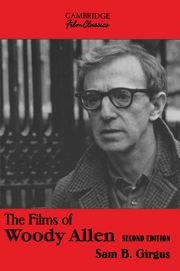Book contents
- Frontmatter
- Contents
- Acknowledgments
- Introduction to the Second Edition – The Prisoner of Aura: The Lost World of Woody Allen
- 1 Reconstruction and Revision in Woody Allen's Films
- 2 Desire and Narrativity in Annie Hall
- 3 Manhattan
- 4 The Purple Rose of Cairo – Poststructural Anxiety Comes to New Jersey
- 5 Hannah and Her Sisters
- 6 The Eyes of God
- Conclusion to the Second Edition – Allen's Fall: Mind, Morals, and Meaning in Deconstructing Harry
- Filmography
- Selected bibliography
- Index
Introduction to the Second Edition – The Prisoner of Aura: The Lost World of Woody Allen
Published online by Cambridge University Press: 14 January 2010
- Frontmatter
- Contents
- Acknowledgments
- Introduction to the Second Edition – The Prisoner of Aura: The Lost World of Woody Allen
- 1 Reconstruction and Revision in Woody Allen's Films
- 2 Desire and Narrativity in Annie Hall
- 3 Manhattan
- 4 The Purple Rose of Cairo – Poststructural Anxiety Comes to New Jersey
- 5 Hannah and Her Sisters
- 6 The Eyes of God
- Conclusion to the Second Edition – Allen's Fall: Mind, Morals, and Meaning in Deconstructing Harry
- Filmography
- Selected bibliography
- Index
Summary
For years, Woody Allen, the eccentric and nervous, obsessive and compulsive, Jewish New Yorker was also the man who seemed to have it all together – life, art, work, love. This appeared to be especially true during his 11- to 12-year relationship with Mia Farrow. By most accounts, the success of his unusual domestic arrangement with Mia Farrow and their brood matched the success of his life and work in film; and in film, Allen's brilliance as director, writer, and star with final authority over production made him a historic figure of accomplishment, a judgment about his overall work that still holds true today. By the time of his relationship with Farrow, Allen had triumphed not only in film but in many books, articles, and performances as well. At that point in his life, Allen's record of achievement signified a degree of international success and recognition that made his career in comedy and film comparable even with Charlie Chaplin's.
However, in contrast to Chaplin, who usually performed as The Tramp, Allen invariably plays himself, thinly disguising himself as various film characters who are themselves fictionalized versions of Allen's own manufactured identity as Woody Allen. In the case of Chaplin, the mask of The Tramp established some protection for his career in the midst of scandals involving young women. For Allen, no such cover exists.
- Type
- Chapter
- Information
- The Films of Woody Allen , pp. 1 - 19Publisher: Cambridge University PressPrint publication year: 2002



